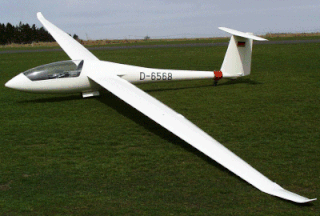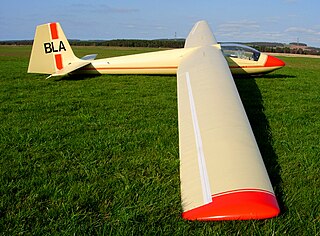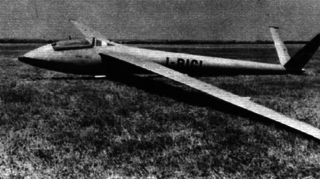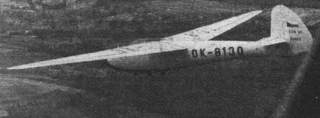
The Schempp-Hirth Ventus is a sailplane produced during 1980–1994 by Schempp-Hirth, a German sailplane manufacturer. It was designed by Klaus Holighaus and replaced the Schempp-Hirth Mini-Nimbus. Schempp-Hirth manufactured 613 Ventus sailplanes.

The Schempp-Hirth Nimbus-2 is an Open Class glider built by Schempp-Hirth during the 1970s. The Nimbus-2 first flew in April 1971 and a total of over 240 examples of all subtypes have been built until the beginning of the 1980s. It replaced the Schempp-Hirth Cirrus.
Competition classes in gliding, as in other sports, mainly exist to ensure fairness in competition. However the classes have not been targeted at fostering technological development as in other sports. Instead classes have arisen because of:

The ASW 22 is an Open Class glider built by Alexander Schleicher GmbH & Co which first flew in 1981. The 'W' in the designation indicates that this is a product of the German designer Gerhard Waibel. An ASW 22 broke the world 750 km triangle speed record in 1985 and ASW 22s have won first place in six World Gliding Championships.

The Slingsby T.41 Skylark 2 was a sailplane produced from 1953 by Slingsby Sailplanes at Kirkbymoorside, Yorkshire.

The Slingsby T.37 Skylark 1 was a small low-cost sailplane built during 1952-3 at Kirbymoorside, Yorkshire by Slingsby Sailplanes.

The SZD-41 Jantar Standard was a Standard Class glider designed and produced in Poland from 1973.

In 1947 a British Gliding Association design competition, for a two-seat sailplane, was won by Hugh Kendall, Miles' assistant test pilot. It was a side-by-side two seater called the Kendall Crabpot I, with a 60 ft. span and an aspect ratio of 18. A version with a novel asbestos fibre-polymer wing and a wooden fuselage with a butterfly tail was proposed by Miles, but the wing failed under low loads. Elliotts of Newbury built a conventional wooden wing to use with Miles' fuselage. The resulting glider flew, but not well and development was abandoned with just one example built.

The Slingsby T.30 Prefect is a 1948 British modernisation of the 1932 single-seat Grunau Baby glider. About 53 were built for civil and military training purposes.

The Slingsby T.43 Skylark 3 was a single seat Open Class sailplane developed from the Skylark 2 with an extended wingspan. It won the 1960 World Gliding Championships.

The Slingsby T.50 Skylark 4 was a British single seat competition glider built by Slingsby Sailplanes in the early 1960s. It sold in numbers and had success at national, though not world level competition.

The DFS Weihe is a German single-seat, high-wing, 18 metre wingspan, high-performance glider that was designed by Hans Jacobs in 1937-38.
The Stedman TS-1 City of Leeds was a parasol wing wooden sailplane, seating two in tandem open cockpits. Only one was built, by its designer in 1934; it remained active until the outbreak of World War II.
The Akaflieg Braunschweig SB-11 is an experimental, single seat, variable geometry sailplane designed by aeronautical students in Germany. It won the 15 m span class at the World Gliding Championships of 1978 but its advances over the best, more conventional, opposition were not sufficient to lead to widespread imitation.
The Beatty-Johl BJ-2 Assegai was a single seat, high performance competition glider built in South Africa in the early 1960s. Only one was built; it was optimised for South African conditions and performed well there, winning two nationals and setting several records, but was less successful under European conditions at the 1965 World Gliding Championships.

The Bruni 3V-1 Eolo was a single seat Italian competition glider, first flown in 1955. It took part World Gliding Championships of 1956 but retired early after sustaining damage.
The KAI-14 was a Standard Class sailplane designed and built in the USSR in the 1960s. Two participated in the World Gliding Championships of 1965.

The Schleicher Ka-2 Rhönschwalbe is a tandem two-seat training glider designed and built in Germany, in 1952.

The Zlín Šohaj series of club gliders began as a post World War II development of the DFS Olympia Meise. A large number were built in the 1940s and '50s.

The Jonker JS-3 Rapture is a glider built of glass-fibre, carbon fibre and Kevlar. It has full-span flaps and can be operated with a wingspan of either 15 m (49.2 ft) or 18 m (59.1 ft).
















